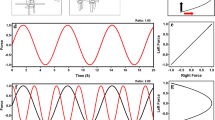Abstract.
Schöner [Schöner G (1995) Ecol Psychol 7: 291–314] argued that the relative phase dynamics of rhythmic interlimb coordination may be attributed to the timing level in that the stability properties of the relative phase are largely independent of dynamical principles operating at the goal level, such as those related to the maintenance of a particular amplitude or target position. Yet, according to the coupling functions in the coupled oscillator model proposed by Haken et al. [Haken H, Kelso JAS, Bunz H (1985) Biol Cybern 51: 347–356], the effect of frequency on the stability properties of relative phase is either wholly or partially mediated by frequency-induced changes in amplitude, implying that the relative phase dynamics strongly depends on spatial factors. In order to distinguish between these contrasting interpretations of the organizational principles underwriting the phase dynamics of interlimb coordination, an experiment was conducted in which the effects of frequency and amplitude on the stability of relative phase were separated. Six subjects performed both in-phase and anti-phase coordination patterns at seven different frequencies and three different amplitudes. Two measures of pattern stability were used, the standard deviation of relative phase and the exponent of the relaxation process following phasic perturbations of relative phase. According to both measures, pattern stability decreased with increasing frequency, whereas the amplitude manipulation only had a significant effect on the standard deviation of relative phase. This result was interpreted to imply that the organizational principles at the (relative) timing level are affected only moderately by task constraints pertaining to the goal level, and that models of interlimb coordination in which amplitude coupling plays a partial or subordinate role should be preferred above models relying solely on amplitude coupling.
Similar content being viewed by others
Author information
Authors and Affiliations
Additional information
Received: 27 March 2000 / Accepted: 12 May 2000
Rights and permissions
About this article
Cite this article
Post, A., Peper, C. & Beek, P. Relative phase dynamics in perturbed interlimb coordination: the effects of frequency and amplitude. Biol Cybern 83, 529–542 (2000). https://doi.org/10.1007/s004220000185
Issue Date:
DOI: https://doi.org/10.1007/s004220000185




